Effect of Impulse Polarity on a New Grounding Device with Spike Rods (GDSR)
Abstract
:1. Introduction
2. Experimental Arrangement
3. Test Results
3.1. Time to Peak Current
3.2. Discharge Time
3.3. Impulse Impedances, Zimpulse
4. Conclusions
Author Contributions
Funding
Conflicts of Interest
References
- Kuffel, E.; Zaengl, W.S.; Kuffel, J. High Voltage Engineering: Fundamentals; Butterworth-Heinemann: Oxford, UK, 2000. [Google Scholar]
- Zhao, S.; Xiao, D.; Xue, P.; Zhong, R. Experimental Research on Polarity Effect of CF3I/N2 Mixtures under Lightning Impulse. IEEE Trans. Dielectr. Electr. Insul. 2018, 25, 1357–1363. [Google Scholar] [CrossRef]
- Meyer, H.K.; Mauseth, F.; Pedersen, A.; Ekeberg, J. Breakdown Mechanisms of Rod-Plane Air Gaps with a Dielectric Barrier Subject to Lightning Impulse Stress. IEEE Trans. Dielectr. Electr. Insul. 2018, 25, 1121–1127. [Google Scholar] [CrossRef] [Green Version]
- Rapp, K.J.; Corkran, J.; McShane, C.P. Lightning Impulse Testing of Natural Ester Fluid Gaps and Insulation Interfaces. IEEE Trans. Dielectr. Electr. Insul. 2009, 16, 1595–1603. [Google Scholar] [CrossRef]
- Hanaoka, R.; Kohrin, T.; Miyagawa, T.; Nishi, T. Creepage Discharge Characteristics over Solid-liquid Interfaces with Grounded Side Electrode. IEEE Trans. Dielectr. Electr. Insul. 2002, 9, 308–315. [Google Scholar] [CrossRef]
- Darveniza, M. Electrical Breakdown of Air between Insulated Conductors. In Proceedings of the 6th International Conference on Properties and Applications of Dielectric Materials, Xi’an, China, 21–26 June 2000. [Google Scholar]
- Hogg, M.; Timoshkin, I.V.; Given, M.J.; Wilson, M.P.; MacGregor, S.J.; Fouracre, R.A.; Lehr, J.M. Liquid Water Stressed with HV impulses: Effect of Polarity on Transient Pre-breakdown Processes. In Proceedings of the 17th IEEE International Conference on Dielectric Liquids, Trondheim, Norway, 26–30 June 2011. [Google Scholar]
- Li, X.; Chen, X.; Li, J. On Polarity Effect of Underwater Impulse Breakdown. In Proceedings of the 20th IEEE International Conference on Dielectric Liquids (ICDL), Roma, Italy, 23–27 June 2019. [Google Scholar]
- Petropoulos, G.M. The High-Voltage Characteristics of Earth Resistances. J. IEE Part II 1948, 95, 172–174. [Google Scholar]
- Victor, M.; Cabrera, M. Photographic Investigation of Electric Discharges in Sandy Media. J. Electrost. 1993, 30, 47–56. [Google Scholar] [CrossRef]
- Victor, M.; Cabrera, M.; Lundquist, S.; Cooray, V. On the Physical Properties of Discharges in Sand under Lightning Impulses. J. Electrost. 1993, 30, 17–28. [Google Scholar] [CrossRef]
- Loboda, M.; Scuka, V. On the Transient Characteristics of Electrical Discharges and Ionization processes in soil. In Proceedings of the 23rd International Conference on Lightning Protection Proceedings, Firenze, Italy, 23–27 September 1996; pp. 539–544. [Google Scholar]
- Nor, N.M.; Haddad, A.; Griffiths, H. Factors Affecting Soil Characteristics under Fast Transients. In Proceedings of the International Conference on Power Systems Transients-IPST 2003, New Orleans, LA, USA, 28 September–2 October 2003. [Google Scholar]
- Nor, N.M.; Ramli, A. Soil Characteristics under Different Impulse Polarity and Earth Electrode’s Dimensions. IEEE Trans. Dielectr. Insul. 2008, 15, 910–914. [Google Scholar] [CrossRef]
- Reffin, M.S.; Nor, N.M.; Ahmad, N.N.; Abdullah, S.A. Performance of Practical Grounding Systems under High Impulse Conditions. Energies 2018, 11, 3187. [Google Scholar] [CrossRef] [Green Version]
- Ali, A.A.; Ahmad, N.; Nor, N.M.; Reffin, M.; Abdullah, S.S. Investigations on the Performance of a New Grounding Device with Spike Rods under High Magnitude Current Conditions. Energies 2019, 12, 1138. [Google Scholar]
- Ali, A.; Ahmad, N.; Nor, N.M.; Idris, N.; Hanaffi, F. Investigations on the Performance of Grounding Device with Spike Rods (GDSR) with the Effects of Soil Resistivity and Configurations. Energies 2020, 13, 3538. [Google Scholar]
- Rawi, I.; Kadir, M.A.; Gomes, C.; Azis, N. A Case Study on 500 kV Line Performance Related to Lightning in Malaysia. IEEE Trans. Power Deliv. 2018, 33, 2180–2186, No. 5. [Google Scholar] [CrossRef]
- Telekom Malaysia Berhad and Multimedia University. Experiment and Equipment Arrangement (Set Up) for Grounding Assessment under High Impulse Conditions. MALAYSIA—Patent Application No. Pl 2020002177, 30 April 2020. [Google Scholar]







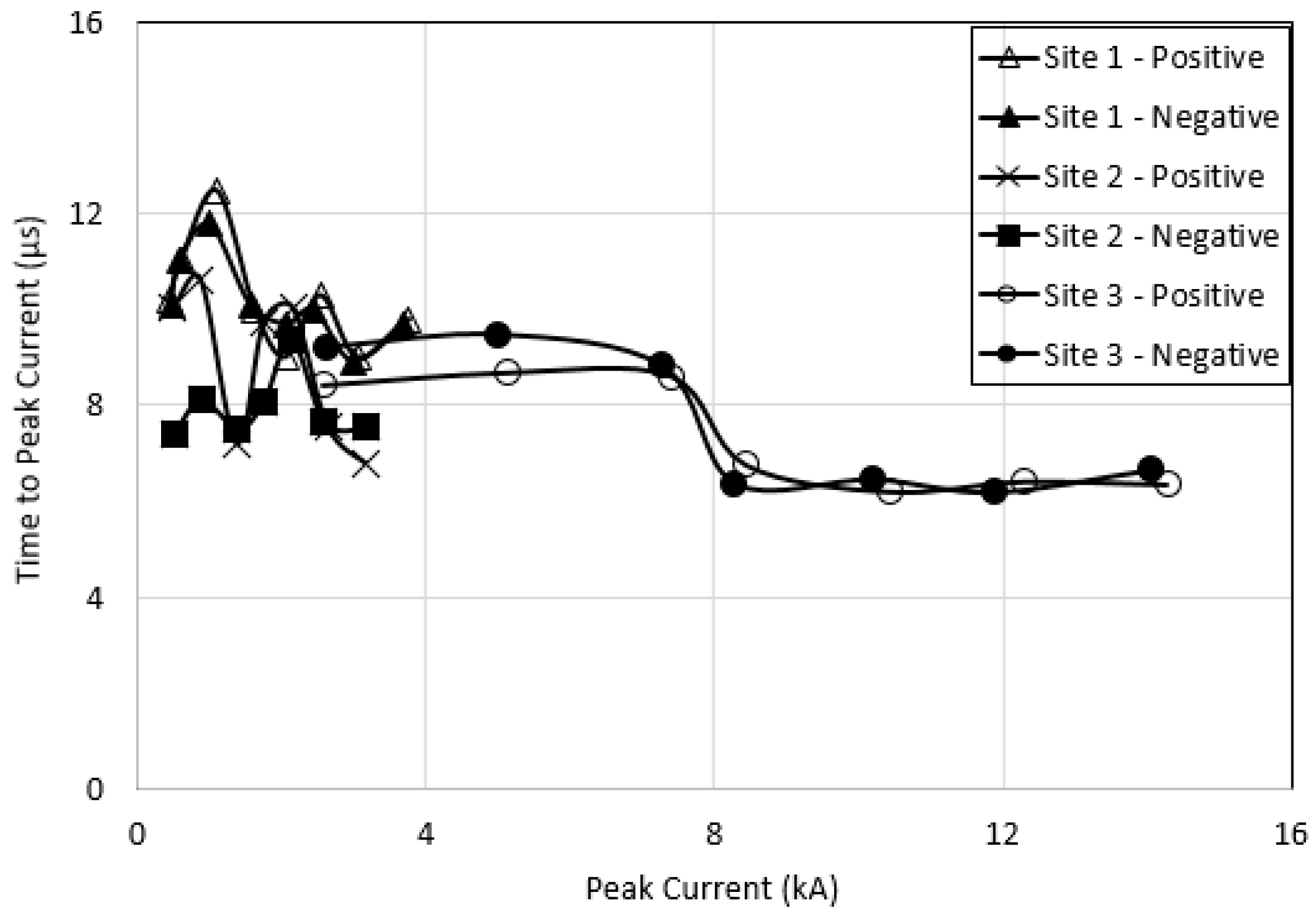
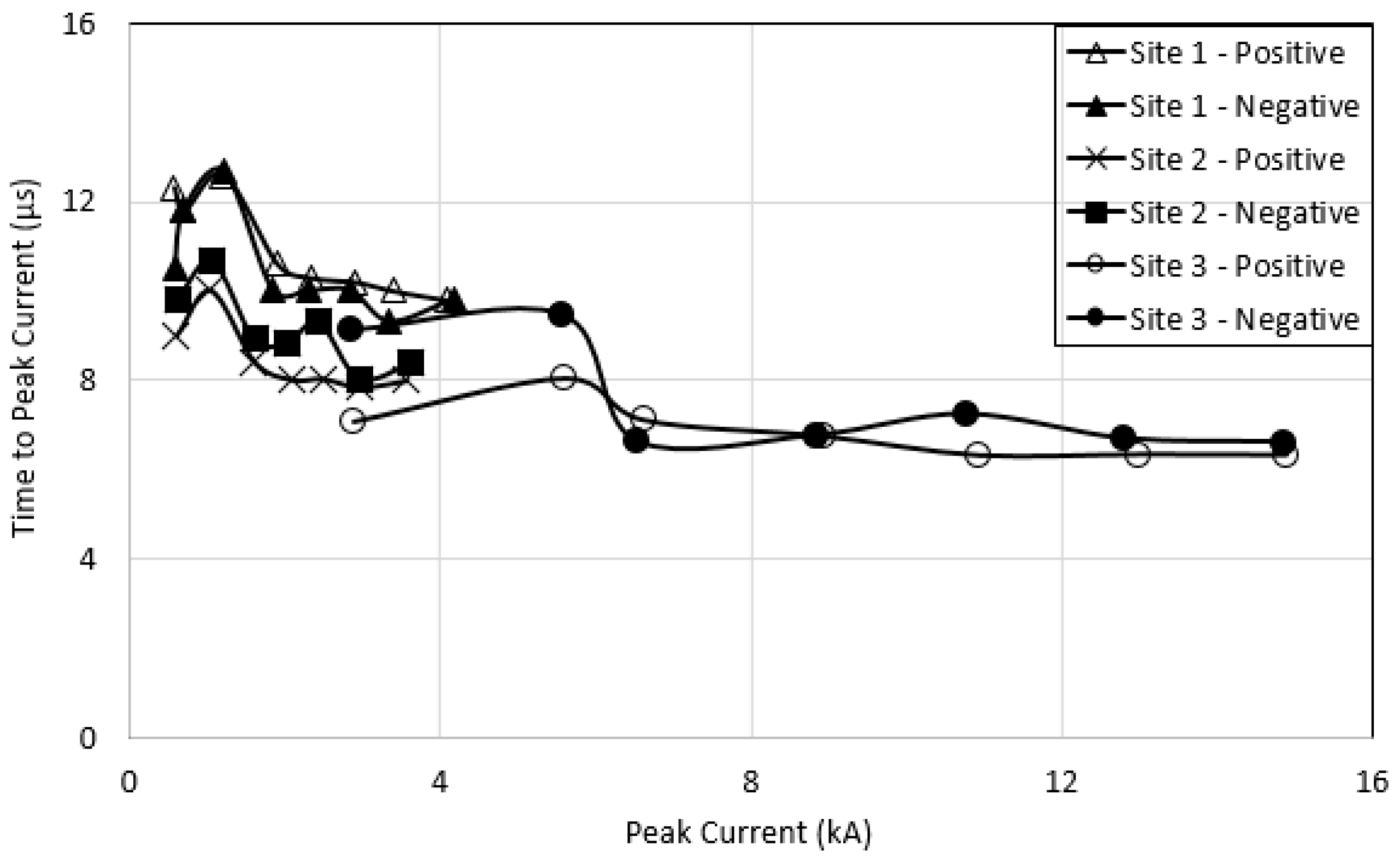


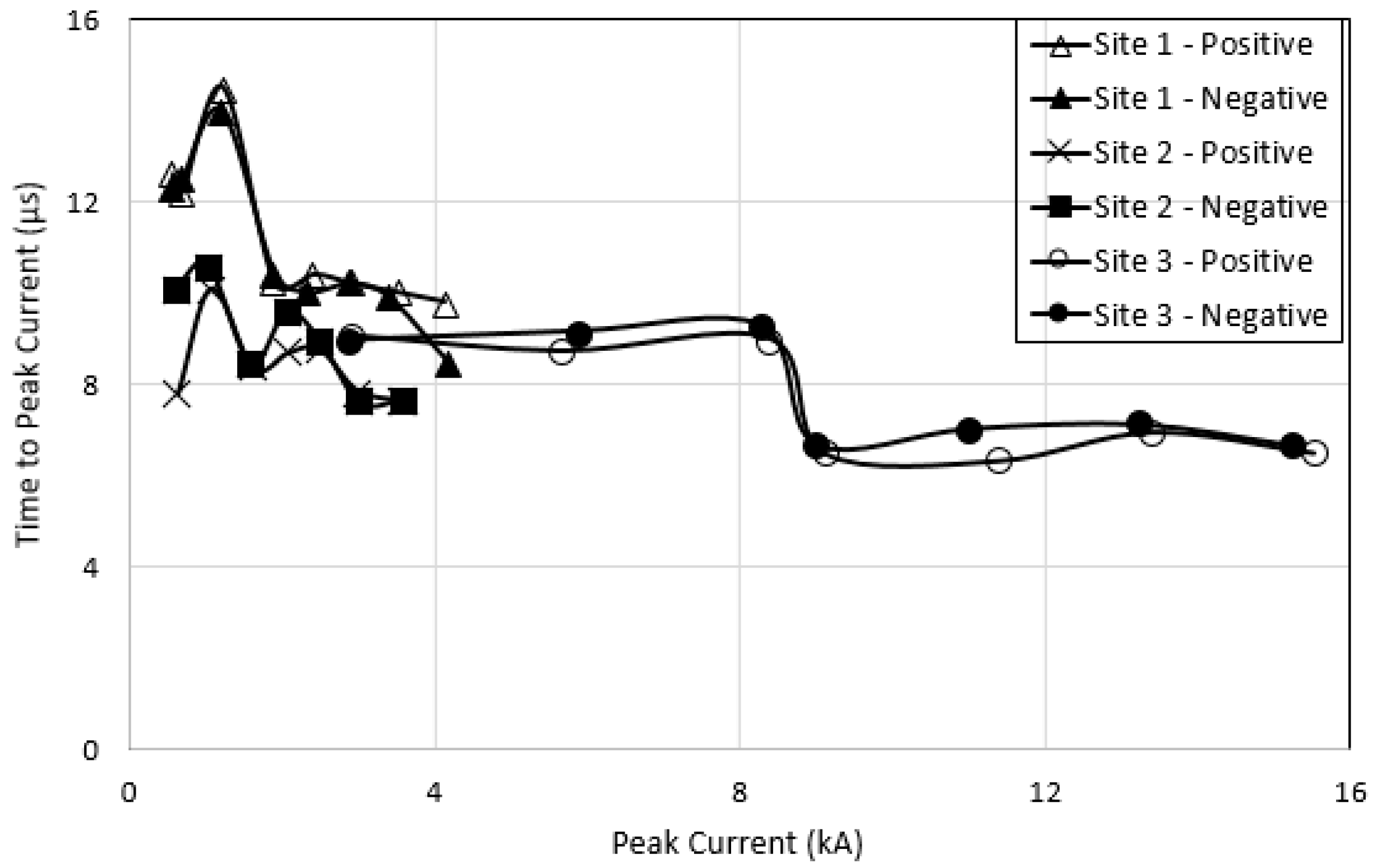
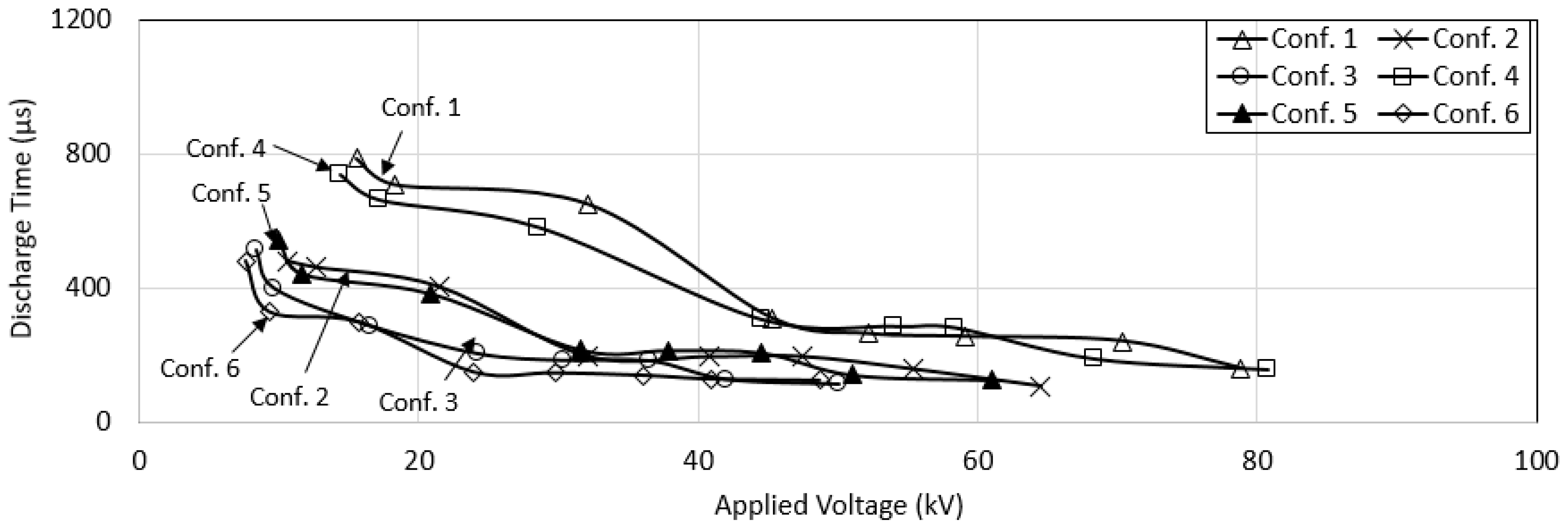



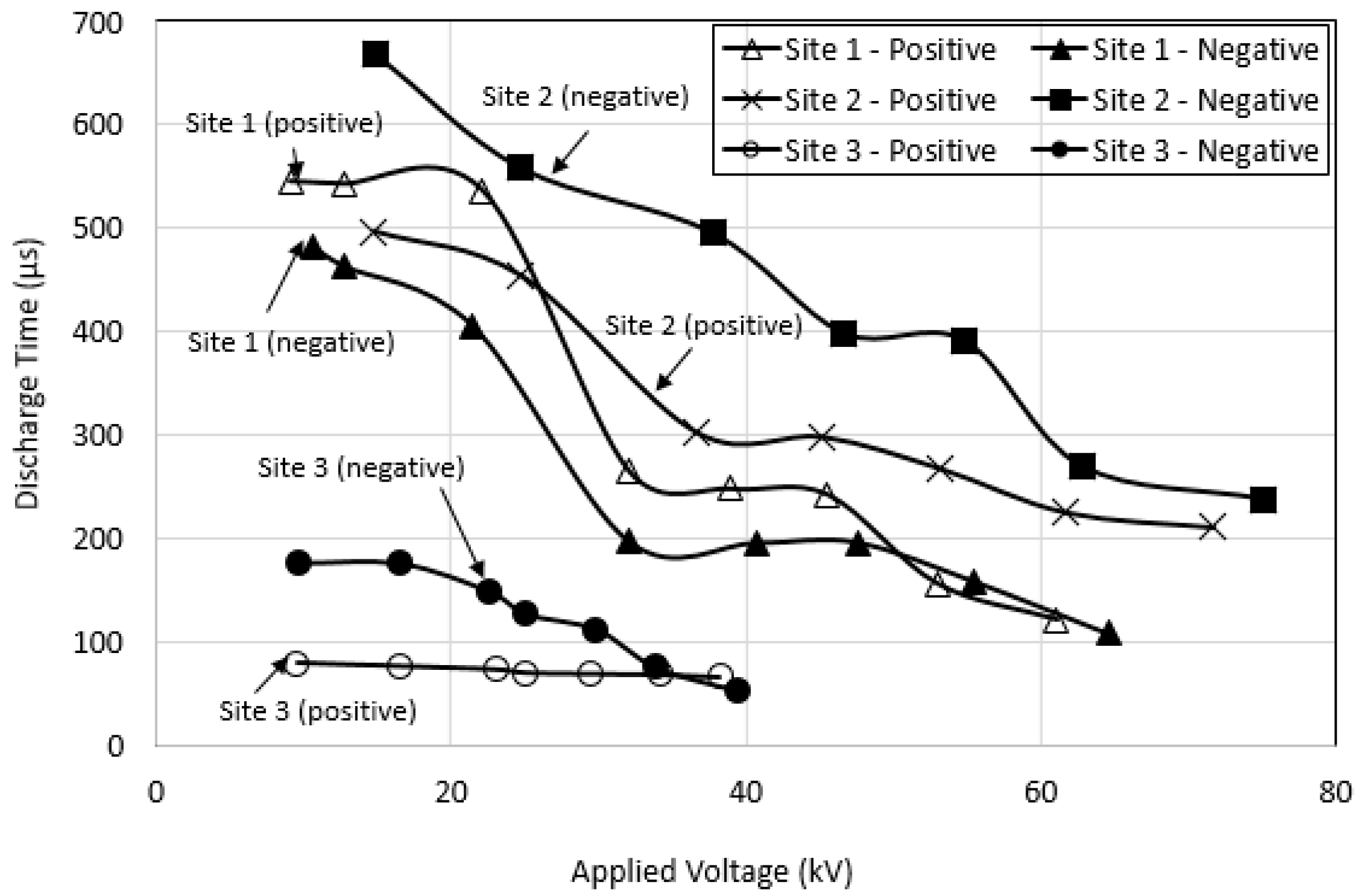
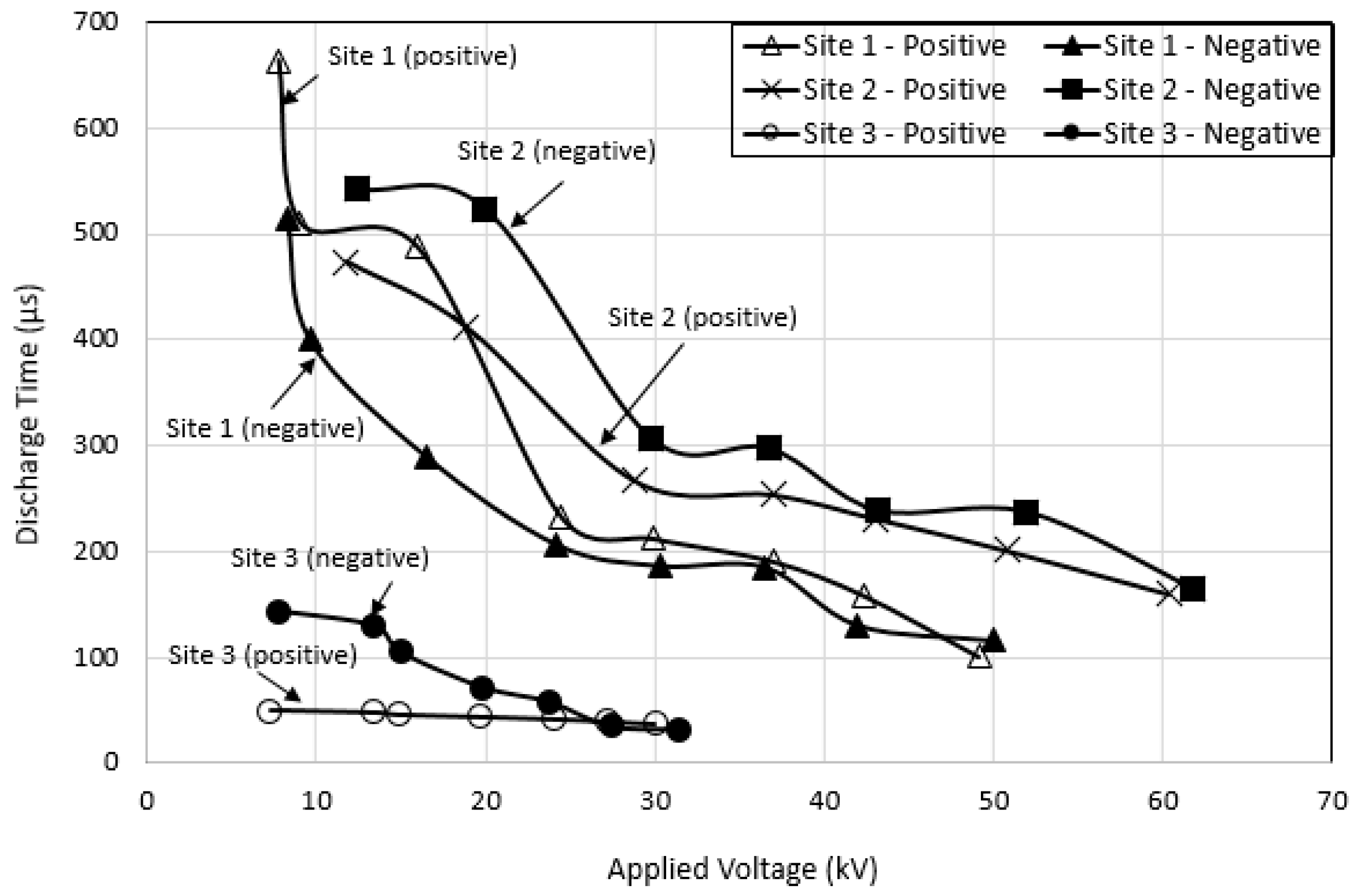
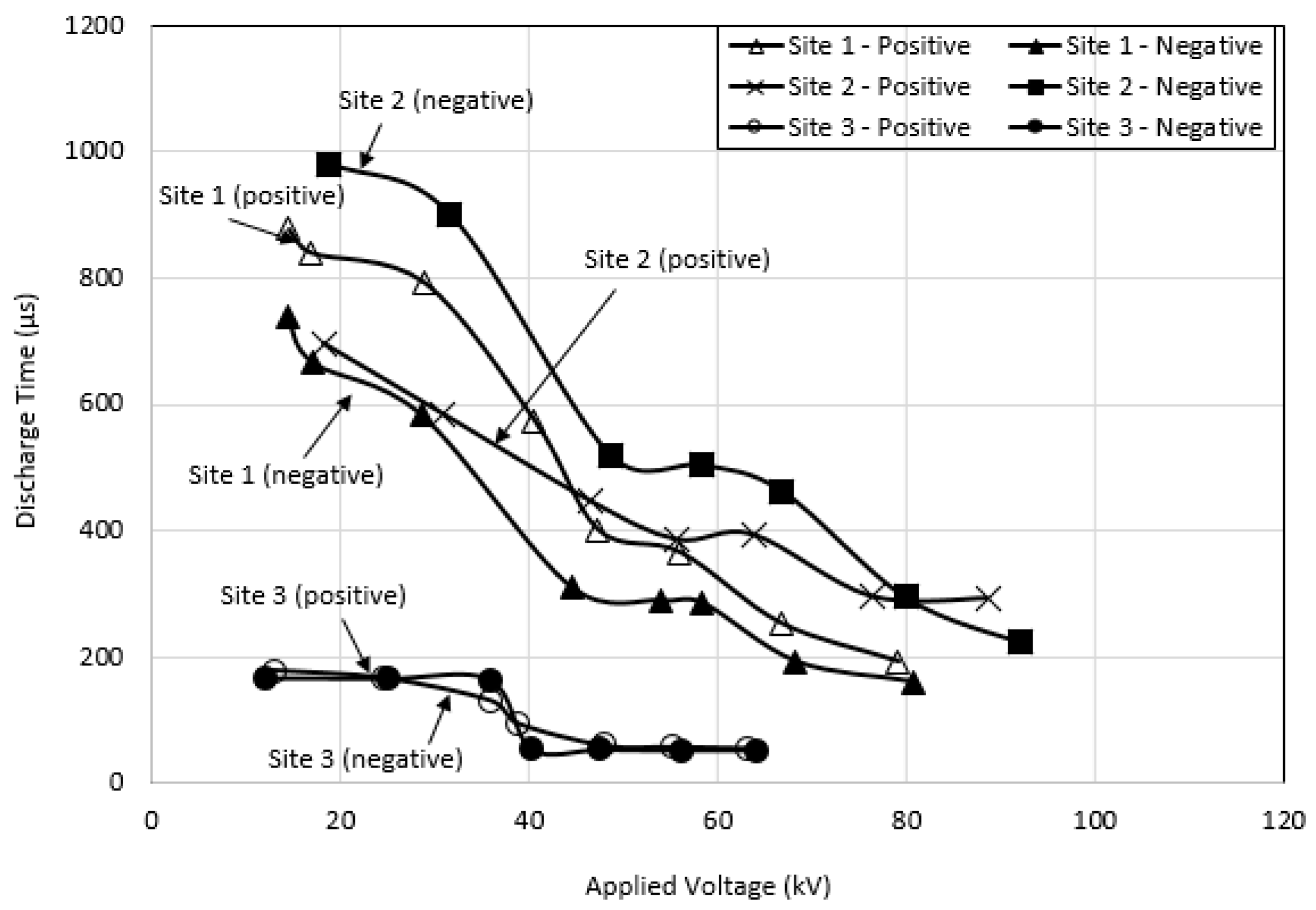




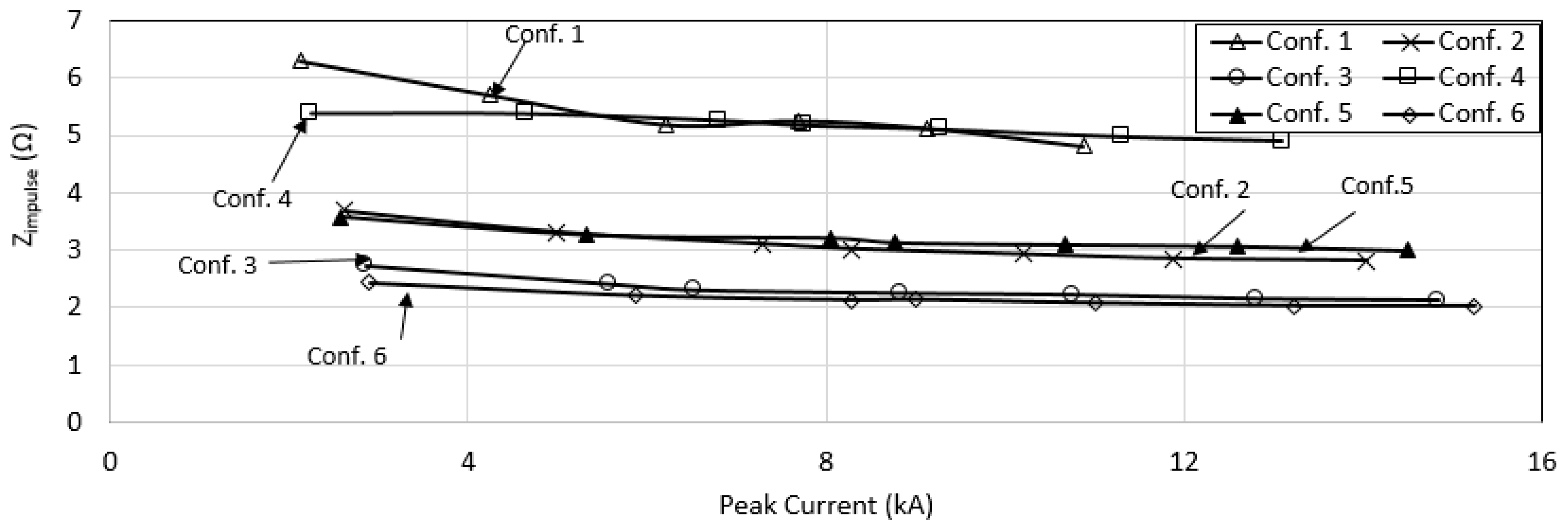


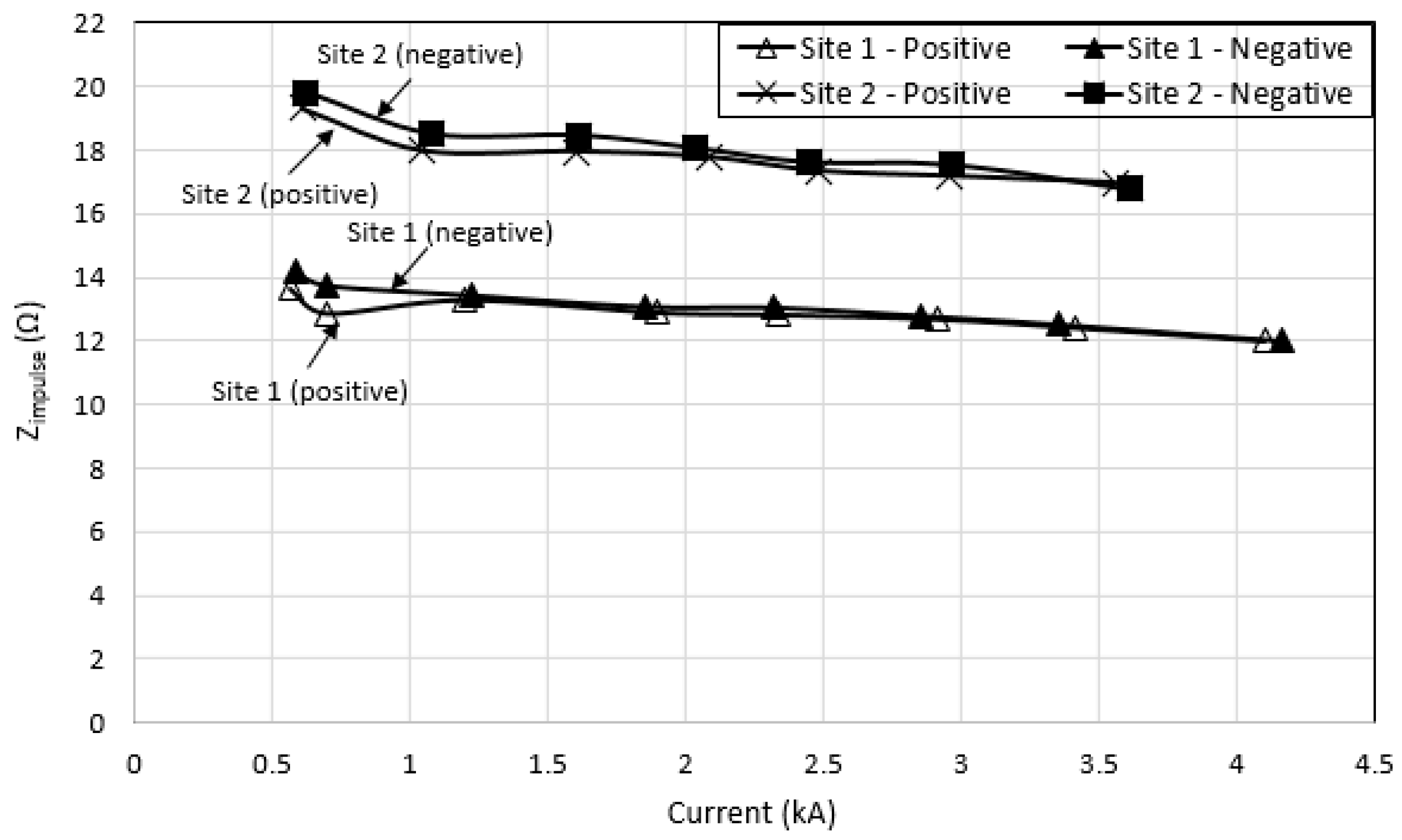
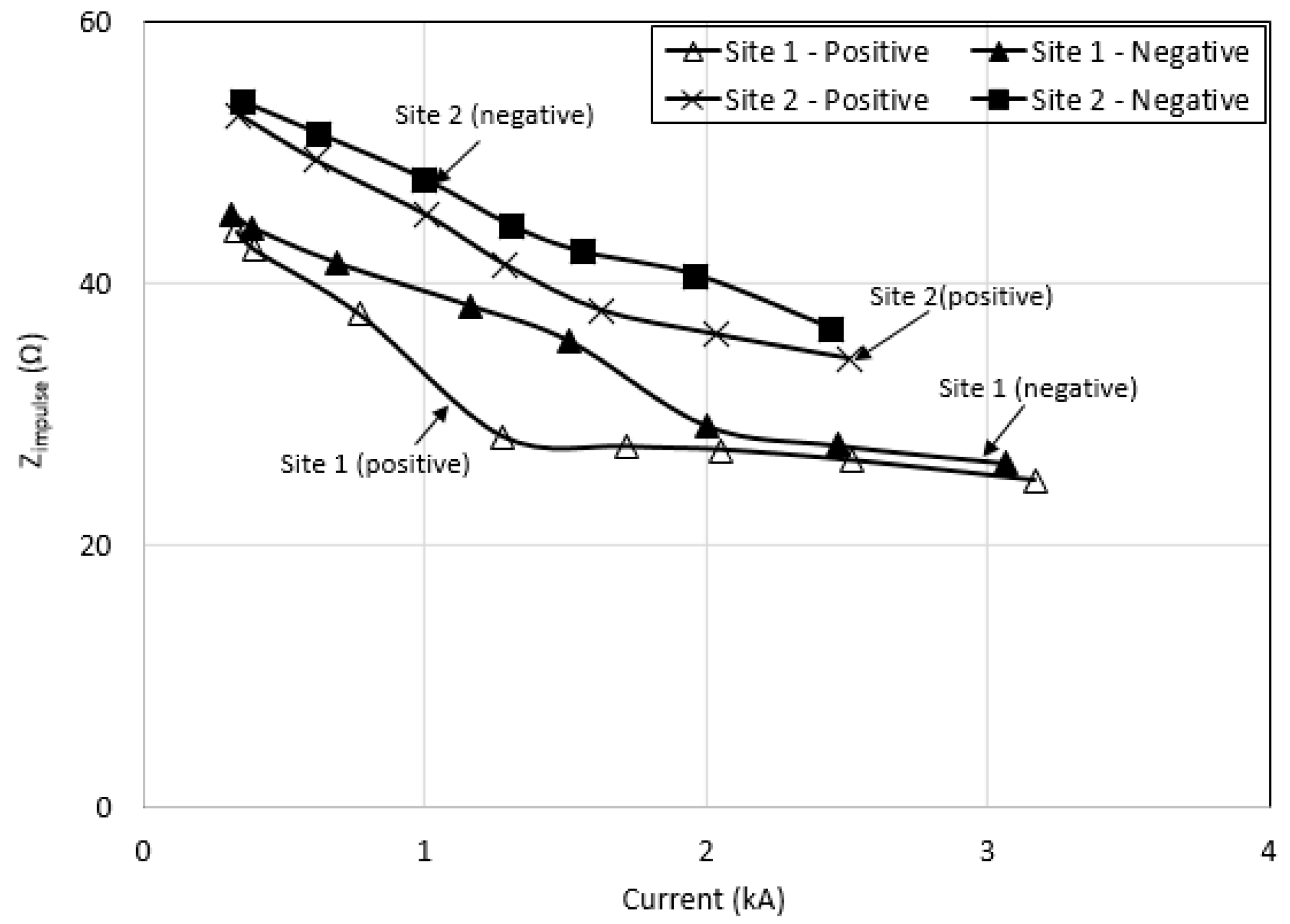
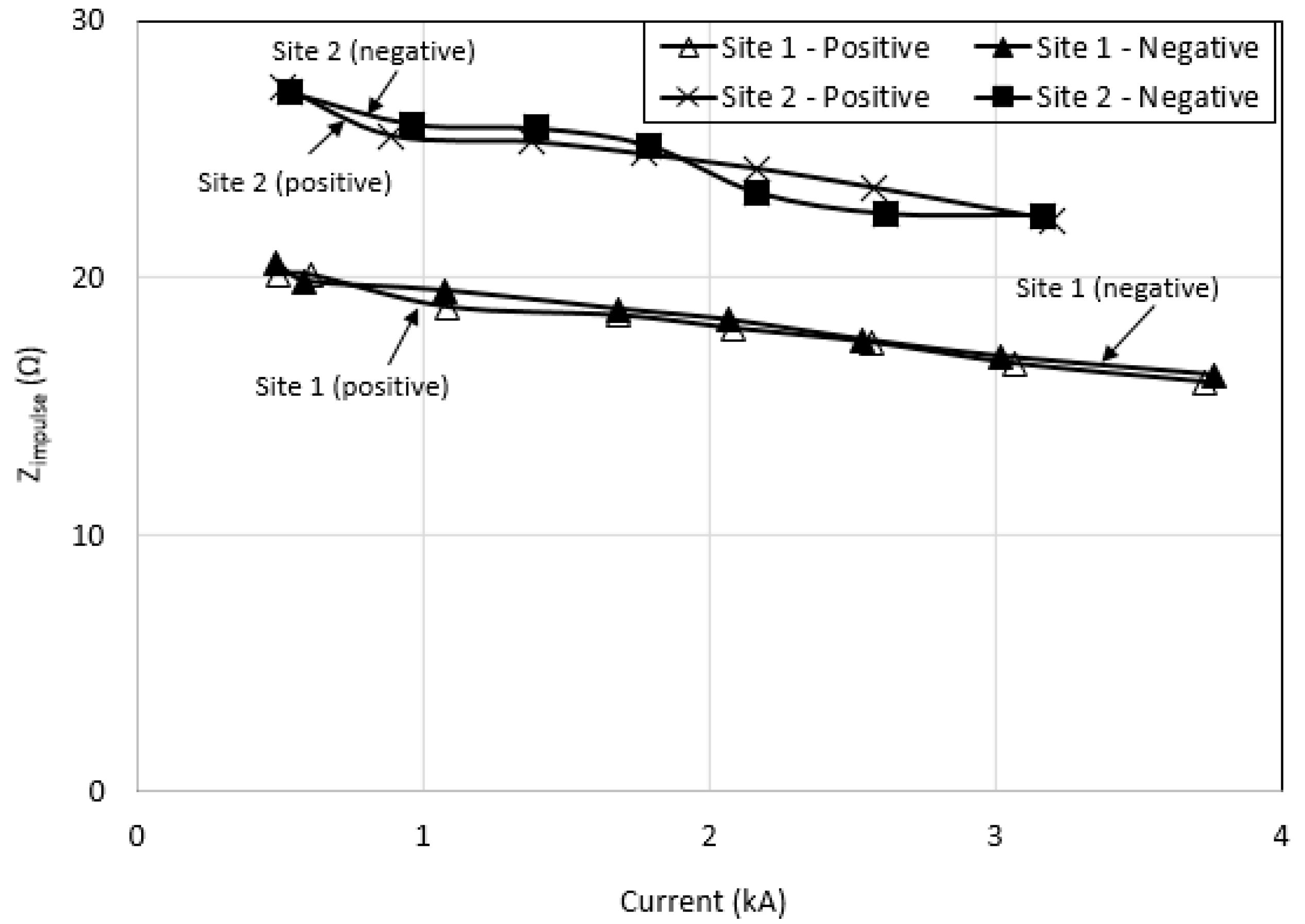

| Location | ρ1 (Ω·m−1) | h1 (m) | ρ2 (Ω·m−1) | h2 (m) |
|---|---|---|---|---|
| Site 1 | 57.2 | 6.0 | 758.1 | ∞ |
| Site 2 | 160.4 | 4.3 | 359.6 | ∞ |
| Site 3 | 3 | 4.9 | 0.2 | ∞ |
| Conf. | Earth Electrode | Rdc (Ω) of Ground Electrodes | ||
|---|---|---|---|---|
| Site 1 | Site 2 | Site 3 | ||
| 1 | A vertical single rod electrode | 67.02 | 104.4 | 75.52 |
| 2 | 2 parallel vertical rod electrodes | 25.02 | 44.8 | 27.56 |
| 3 | 3 parallel vertical rod electrodes | 16.6 | 28.5 | 17.81 |
| 4 | GDSR | 53.0 | 67.2 | 18.5 |
| 5 | GDSR in parallel with vertical one rod electrode | 23.4 | 37.6 | 14.6 |
| 6 | GDSR with spike rods in parallel with two vertical rods | 16.21 | 26.6 | 11.33 |
| Site | Time to Peak Current for Various Earth Electrodes |
|---|---|
| 1 | For the current magnitudes below 2 kA, time to peak current has no direct relation to Rdc values. However, the time to peak current is around 10 μs, independent of earth electrodes, and constant with increasing currents for higher current magnitudes above 2 kA. |
| 2 | The time to peak current is dependent on Rdc values; conf. 1 with the highest Rdc takes the slowest time to reach peak current, at lower current magnitudes below 1.8 kA. The times to peak current are close, around 8 μs, independent of earth electrodes, constant with increasing currents at higher current magnitudes; i.e., above 1.8 kA. |
| 3 | For the current magnitudes below 6 kA, the time to peak current is around 9 μs, independent of Rdc. Between 6 and 9 kA, a drop of time to peak current is seen for all earth electrodes. For the current magnitudes above 9 kA, the time to peak current is around 7 μs, independent of the earth electrodes, constant with increasing currents. |
| Site | Comparison between Negative and Positive Impulse Polarities |
|---|---|
| 1 | Times to peak current for positive impulse polarity are directly dependent on the Rdc of grounding systems, whereas times to peak current for negative impulse polarity are found to occur randomly, and are not directly dependent on Rdc values observed for currents below 2 kA. Similar time to peak current is seen for both impulse polarities, of 10 μs for current magnitudes above 2 kA. |
| 2 | The time to peak current is dependent on Rdc values for both impulse polarities for current magnitudes below 2.5 kA for positive polarity, and 1.8 kA for negative impulse polarity. Time to peak current for the current magnitudes higher than 2.5 and 1.8 kA for positive and negative impulse polarity respectively is constant at 8 μs. |
| 3 | For high Rdc values, slower time to peak current is seen, and this trend is noted for currents below 9 and 6 kA for positive and negative impulse polarity respectively. At higher current magnitudes, time to peak current is constant at 7 μs. |
| Earth Electrode | Time to Peak Current at Various Sites |
|---|---|
| 1 | Time to peak current for earth electrode 1 installed at sites 1 and 2 is close. As the current magnitude increases, faster time to peak current is seen for earth electrode 1 installed at all sites. |
| 2 | Earth electrodes 2 to 6 installed at site 1 have the slowest time to peak current. As the current magnitude increases, faster time to peak current is seen for earth electrodes 2 to 6 installed at all sites. |
| 3 | |
| 4 | |
| 5 | |
| 6 |
| Earth Electrode | Comparison between Negative and Positive Impulse Polarities |
|---|---|
| 1 | Earth electrode 1 installed at site 2 has the slowest time to peak current when subjected to positive impulse. When subjected to negative impulse polarity, the slowest time to peak current is seen for earth electrode 1 installed at site 1. Faster time to peak current is seen when the current magnitudes increase, for all earth electrodes subjected to both impulse polarities. |
| 2 | |
| 3 | |
| 4 | |
| 5 | |
| 6 |
| Site | Discharge Time for Various Earth Electrodes |
|---|---|
| 1 | Faster discharge time with increasing applied voltage for all earth electrodes installed at sites 1 and 2. |
| 2 | Discharge time is dependent on the values of Rdc; the higher the Rdc, the slower the discharge time. |
| 3 | Discharge time for all earth electrodes decreases with increasing applied voltage. Earth electrode 4 has a rather abnormal trend in discharge time, which is found constant for applied voltage levels below 35 kV, and abruptly drops at higher applied voltage levels. For other earth electrodes, discharge time is dependent on Rdc values, with a slower discharge time for earth electrodes with high Rdc. |
| Site | Comparison between Negative and Positive Impulse Polarities |
|---|---|
| 1 | Faster discharge time as the applied voltage increases, and depending on the values of Rdc is seen for both impulse polarities; i.e., faster discharge time for earth electrodes with low Rdc, and slower discharge time for earth electrodes with high Rdc for both positive and negative polarities. |
| 2 | |
| 3 | Faster discharge time with increasing applied voltage for negative impulse polarity, whereas it is found to be constant for positive impulse polarity. Discharge time is dependent on Rdc values for negative impulse, but discharge time is hardly dependent on Rdc values for positive impulse polarity. Earth electrode 4 has a significant reduction in discharge time for both impulse polarities. |
| Earth Electrode | Discharge Time at Various Sites |
|---|---|
| 1 | Discharge time decreases with increasing applied voltage for all earth electrodes installed at all sites. It is observed that discharge time is the highest for earth electrodes installed at site 2, followed by sites 1 and 3. Large differences between discharge times for sites 1, 2 and 3; i.e., difference between discharge times for earth electrodes 1 and 2 at site 1 is as large as 400 μs for the same peak current magnitudes. |
| 2 | |
| 3 | |
| 4 | |
| 5 | |
| 6 |
| Earth Electrode | Comparison between Negative and Positive Impulse Polarities |
|---|---|
| 1 | Faster discharge time as applied voltage is increased for all earth electrodes installed at all sites for negative impulse polarity, but for positive impulse polarity, only earth electrodes installed at sites 1 and 2 have a similar relationship, that there is faster discharge time at higher applied voltage. For earth electrodes installed at site 3, discharge time is mostly not dependent on applied voltage. For the same earth electrode, distinctive differences are seen between the discharge times for earth electrodes installed at sites 1 and 2, or between sites 2 and 3 for negative impulse polarity, reaching differences of hundreds of microseconds, while for positive impulse polarity, large differences in discharge time are only observed for earth electrodes installed at sites 2 and 3. Small differences, or close results for time for current to discharge to zero between earth electrodes installed at sites 1 and 2 when subjected to positive impulse. |
| 2 | |
| 3 | |
| 4 | |
| 5 | |
| 6 |
| Site | Zimpulse for Various Earth Electrodes |
|---|---|
| 1 | Higher Zimpulse for earth electrodes with high Rdc installed at all sites. Zimpulse decreases as the current magnitudes are increased for earth electrodes 1 and 4 (high Rdc). |
| 2 | |
| 3 |
| Site | Comparison between Negative and Positive Impulse Polarities |
|---|---|
| 1 | Similar trend for both positive and negative impulse polarities are seen, higher Zimpulse for high Rdc, and reduction of Zimpulse is seen most significant for earth electrodes 1 and 4 (high Rdc). |
| 2 | |
| 3 |
| Earth Electrodes | Zimpulse at Various Sites |
|---|---|
| 1 | Higher Zimpulse values for all earth electrodes installed at site 2 than for earth electrodes installed at site 1. Zimpulse values decrease significantly with increasing magnitudes of current for earth electrode 1 installed at sites 1 and 2, while Zimpulse values are almost linear with increasing current magnitudes for earth electrode 1 installed at site 3 (low soil resistivity). |
| 2 | |
| 3 | |
| 4 | |
| 5 | |
| 6 |
| Earth Electrodes | Comparison between Negative and Positive Impulse Polarities |
|---|---|
| 1 | For earth electrode 1, installed at site 1, Zimpulse values are higher than for that installed at site 2 when subjected to positive impulse polarity, but for negative impulse polarity, Zimpulse values are higher for earth electrodes installed at site 2, than for those at site 1 for all earth electrodes. For both impulse polarities, Zimpulse decreases significantly as the current increases for all earth electrodes installed at sites 1 and 2, while Zimpulse values are almost constant as the current magnitudes increase for all earth electrodes installed at site 3. A significant difference in Zimpulse between positive and negative polarities is seen for earth electrodes 1 and 4, installed at both sites 1 and 2, which could be due to high Rdc (see Figure 25 and Figure 28). |
| 2 | |
| 3 | |
| 4 | |
| 5 | |
| 6 |
© 2020 by the authors. Licensee MDPI, Basel, Switzerland. This article is an open access article distributed under the terms and conditions of the Creative Commons Attribution (CC BY) license (http://creativecommons.org/licenses/by/4.0/).
Share and Cite
Abdul Ali, A.W.; Ahmad, N.N.; Mohamad Nor, N. Effect of Impulse Polarity on a New Grounding Device with Spike Rods (GDSR). Energies 2020, 13, 4672. https://doi.org/10.3390/en13184672
Abdul Ali AW, Ahmad NN, Mohamad Nor N. Effect of Impulse Polarity on a New Grounding Device with Spike Rods (GDSR). Energies. 2020; 13(18):4672. https://doi.org/10.3390/en13184672
Chicago/Turabian StyleAbdul Ali, Abdul Wali, Nurul Nadia Ahmad, and Normiza Mohamad Nor. 2020. "Effect of Impulse Polarity on a New Grounding Device with Spike Rods (GDSR)" Energies 13, no. 18: 4672. https://doi.org/10.3390/en13184672





